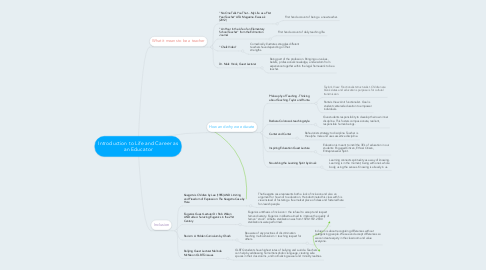
1. What it means to be a teacher
1.1. "No One Tells You That....My Life as a First Year Teacher" ATA Magazine. Ewasiuk (2012)
1.1.1. First hand account of being a a new teacher.
1.2. "An Hour In the Life of an Elementary School Teacher" from the Edmonton Journal
1.2.1. First hand account of daily teaching life.
1.3. "Chalk Video"
1.3.1. Comedically illustrates struggles different teachers have depending on their strengths.
1.4. Dr. Mark Yurick, Guest Lecturer
1.4.1. Being part of the profession. Bringing our values, beliefs, professional knowledge, and wisdom from experience together within the legal framework to be a teacher.
2. How and why we educate
2.1. Philosophy of Teaching - Thinking about Teaching. Taylor and Runte.
2.1.1. Taylor's View: Functionalist structuralist. Children are blank slates and educations purpose is for cultural transmission.
2.1.2. Runte's View: Anti functionalist. Goal is student centered education to empower individuals.
2.2. Barbara Coloroso's teaching style
2.2.1. Give students responsibility to develop their own inner discipline. This fosters compassionate, resiliant, responsible human beings.
2.3. Canter and Canter
2.3.1. Behaviorists strategy to discipline. Teacher is the alpha male and uses assertive discipline.
2.4. Inspiring Education Guest Lecture
2.4.1. Education is meant to instil the 3E's of education in our students: Engaged Citizen, Ethical Citizen, Entrepreneurial Spirit.
2.5. Nourishing the Learning Spirit by Anuik
2.5.1. Learning connects spirituality as a way of knowing. Learning is in the moment, being with one's whole body, using the senses. Knowing is already in us.
3. Inclusion
3.1. Keegsrta's Children by Lee (1985) AND Limiting and Freedom of Expression: The Keegstra Case by Hare
3.1.1. The Keegstra case represents both a lack of inclusion and also an argument for how not to education. He indoctrinated his class with his view instead of fostering a free market place of ideas and fostered hate for Jewish people.
3.2. Eugenics Guest Lecturer Dr. Rob Wilson AND video: Surviving Eugenics in the 21st Century
3.2.1. Eugenics antithesis of inclusion = the refusal to accept and respect human diversity. Eugenics in Alberta aimed to improve the quality of human "stock". Alberta sterilization was from 1928-1972. 2830 sterilizations were performed.
3.3. Racism: A Hidden Curriculum by Ghosh
3.3.1. Be aware of any practices of discrimination. Teaching multiculturalism = teaching respect for others.
3.3.1.1. Inclusion is about recognizing differences without categorizing people. We see and accept differences so we can create equity in the classroom and value everyone.
3.4. Bullying Guest Lecturer Melinda McNie on GLBTQ issues
3.4.1. GLBTQ students have highest rates of bullying and suicide. Teachers can help by addressing homo/transphobic language, creating safe spaces in their classrooms, and normalizing sexual and minority realities.
